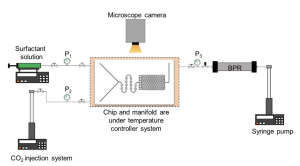Microfluidic testing. Figure 2 shows the microfluidic chip design used to screen various supercritical CO2 (Sc-CO2) surfactant foams at different conditions. Te chip has one inlet connected to the surfactant solution and another to the CO2 injection system. An on-chip foam generator comprising a series of off-centered circular mixing channels was designed to produce consistent and uniform Sc-CO2 foams. The relative centers of the circular mixing channel walls of 0.5 mm inner diameter and 1.0 mm outer diameter were radially displaced by 0.05–0.1 mm. Te foam generator channel dimensions are 200 µm (width)×10 µm (depth).
The porous medium of the microfluidic chip is a homogeneous hexagonal channel network where the foam behavior at the pore-scale level of the reservoir rock is replicated and studied. The porous medium has pore dimensions of 30 µm (width)×10 µm (depth), correlating to a hydraulic radius of 15 µm. The pattern was transferred onto a silicon substrate and etched to the specified dimensions using reactive ion etching (RIE). To complete the fabrication, the RIE-etched silicon substrate was anodically bonded to a glass slide to seal of the analog from the atmosphere, provide a viewing window, and sustain microchannel pressures >13.8 MPa. Figure 3 shows the schematic of the experimental setup used to conduct the microfluidic testing. A new microfluidic chip was used for each test to ensure that the initial chip condition was the same for all experiments.
The microfluidic chip was mounted onto an in-house designed high-temperature high-pressure manifold and connected to the external experimental system: a syringe pump for surfactant injection (Chemyx Fusion 6000), two pumps for CO2 injection, and back-pressure regulation of the chip outlet pressure, respectively (Teledyne ISCO 260D), and external high-accuracy pressure gauges (Omega Engineering PX409-3.5KGUSBH). Foam testing was performed at 100 °C, and the back-pressure regulator was maintained at 13.8 MPa during foam injection for all microfluidic experiments to maintain CO2 at supercritical conditions. In addition, the entire fluid injection lines from pumps into the microfluidic device were insulated and maintained at the test temperature using a temperature controller (Omega Engineering CNi3222). The pump used to inject the CO2 was kept at the test temperature using a temperature-controlled mineral oil bath circulator and an insulation sleeve. It is also The pump used to inject the CO2 was kept at the test temperature using a temperature-controlled mineral oil bath circulator and an insulation sleeve. It is also noted that due to the high thermal conductivity of the silicon material, the thermal equilibration of fluids occurs quickly and effectively inside the microfluidic chip.

Published by Scientific Reports | (2021)
By AyratGizzatov, Scott Pierobon, ZuhairAlYousef, Guoqing Jian1, Xingyu Fan, AliAbedini & Amr I.Abdel Fattah

